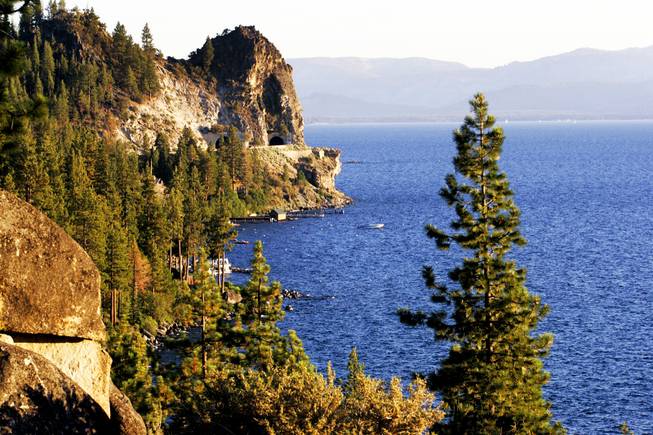
The view of Lake Tahoe from Logan Shoals Vista on the Nevada side of Lake Tahoe on Wednesday, Aug. 10, 2011.
Tuesday, July 23, 2013 | 2 a.m.
A submarine designed to explore beneath the ice shelves of Antarctica took a detour in Lake Tahoe last week for an unusual expedition.
The unmanned vessel dove more than 1,000 feet to scour the lake’s bottom and capture valuable data and high-definition images of an earthquake fault that scientists have wondered about for years.
Since 1998, when the West Tahoe fault was first put on the map, engineers have tried to decipher the underwater fault, which they estimate — based on shore studies — is capable of producing a 7.1 to 7.4 magnitude earthquake and tsunamis up to 30 feet high every 2,500 to 4,000 years.
The last massive temblor was about 4,000 years ago, and scientists say now is the time to get better data.
“I wouldn’t say the earthquake’s overdue. But if it happened tomorrow, I wouldn’t be surprised,” Gordon Seitz, an engineer for the California Geological Survey leading the Lake Tahoe study, said last week. “It’s urgent enough that we want to look at it and figure it out.”
The fault, located along the floor of the lake’s western shore, is the most active of three major faults in the lake.
Using a crane, a team of engineers lowered the 28-foot-long, 2,200-pound submarine into the lake before spending a few days testing the sensors, range and the remote controls that they used to direct the craft.
On Friday, equipped with three video cameras, a laser for measuring objects, an acoustic sounder for profiling layers of the lake floor and other high-tech devices to map and produce X-ray-like images, the vessel dove more than 1,000 feet.
Their target was a six-mile section that Seitz identified as the most active portion of the fault and one that has never been examined.
Before the dive, Seitz said the team was excited to look for evidence of the last big earthquake, which would would help them better assess future dangers.
“In real time, we’ll be able to see it as it’s coming in and, on the fly, we’ll be able to make decisions on what we’ll look at,” Seitz said before the dive. “In a sense, it feels like you’re landing on the moon. You don’t know what you’re going to get.”
Until now, Seitz said, he has captured only rough, distant images from sensors strapped to a boat.
All the results from last week’s submarine dive, combined with recent on-shore studies, will help state officials begin drafting zoning regulations around faults in the Lake Tahoe region.
Reports from the dive will also give state conservation officials and engineers a better sense of earthquake-induced tsunamis, a hazard that experts say would threaten the many homes along the lakeshore. Unlike ocean tsunamis, whose massive waves break and then disappear, a tsunami in Lake Tahoe would go back and forth for hours, hitting one side of the lake and then the other, again and again, Seitz said.
The Lake Tahoe dive was the first test run for the sub, which was developed for a large research expedition in Antarctica by Northern Illinois University and built by DOER Marine, an Alameda robotics firm.
The submarine, rated for a depth of 5,000 feet and capable of collapsing to 22 inches wide, was designed to go under an ice shelf the size of France, according to the university.

Join the Discussion:
Check this out for a full explanation of our conversion to the LiveFyre commenting system and instructions on how to sign up for an account.
Full comments policy